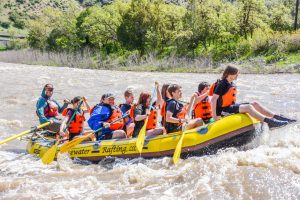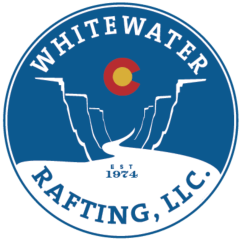Whitewater Rafting Safety Tips: What to Do if You Fall Out of the Raft

Whitewater rafting comes with an inherent risk. The best way to reduce this risk is to go out with a professional guide. Evenstill, while we train our guides to take their utmost care while taking you out on the river, we can never guarantee that you will not fall out of the boat. But we can guarantee that we will prepare you to the best of our ability for the unlikely event that you take a swim on your trip.
The first thing to do is to prepare to go out on the river. Your guide will take care of readying the equipment, so all you need to do is get yourself ready. First, choose the right clothes for the weather and the water conditions. Depending on the time of year, you will need different gear. Even though it may be a nice 80 degrees outside, make sure to check the temperature of the water. Flows in April, May, and early June bring down fresh snowmelt, so water temperatures typically do not exceed 50 degrees. Rafting in these refreshing conditions, even on a sunny day, calls for wetsuits, splash jackets, and warm layers. A good rule of thumb for any cold and/or wet activity: never wear cotton or denim! Once cotton and denim gets wet, it stays wet, cold, and takes your body heat; instead, wear quick-drying and insulating material like wool, polyester, or fleece. If it is a hot day with warm water temperatures, clothing that you are comfortable getting wet in like a swimsuit, sun shirt, or athletic clothing, should work great to keep you cool in the sun and comfortable in the water! If you are not sure what to wear, ask the office for their recommendation for the weather; we’ll have up-to-date information on the river and weather conditions and have cold water rental outfits available for you!
No matter the weather, always wear good shoes that will stay on your feet. Flip flops will immediately get washed off your feet when you go in the water (voluntarily or not), so wear shoes that strap or tie on like Chacos or Tevas. The more protection you have around your feet, the better! If it is cold, wetsuit booties might be best to keep your feet warm and protected; your feet will always be in the water while rafting, so opting for warmer footwear is a good idea!

Now that you are dressed, you need your safety equipment. Personal Floatation Devices (PFDs, also known as life jackets) are a must on the river. There are many types of PFDs out there, but they are not all created equally. Some are designed for lake activities like swimming and jet skiing. Others are made specifically for whitewater rafting and river activities. Always make sure to have the proper PFD for the activity you are doing, ensure it fits you properly, and always wear one when you are on, in, or near the river – even on a nice calm float! We provide PFDs for all of our trips and we have them available to rent if you are going on a private trip but do not have your own. It may also be a good idea to wear a helmet! For our Shoshone trips, we only require helmets at high water flows, but they are always available if you would like one. If you’re going out on your own, each section of river is different, so make sure to do your research and reach out to local companies to get their recommendation. When in doubt, bring a helmet!
Once you have made it to the put-in, make sure everything that you have brought is rigged to flip. This means that all items are secured to the boat in the event that the boat were to fill up with water and wash out any contents, whether that is due to a big wave hit or a flip. Bring a carabiner for your bag and water bottle and grab some chums for your sunglasses.
Next, listen well to the safety speech and your guide. All of our trips start with a descriptive safety speech to ensure that you have the knowledge available to you to help you rescue yourself in the case of a swim or boat flip. Your guide will explain the conditions that you will be rafting in and provide you with specific details about the river. They will also explain the paddle commands and different instructions they may give you during your trip. Finally, they will show you the best ways to stay in the boat and what to do in the unlikely case you should fall overboard.
To prevent falling out, tuck your feet into the boat well; your guide will show you how in the boat you will be rafting in. Make sure to listen to the paddle commands, lean in and paddle hard, and keep paddling through the rapids to keep up the boat’s momentum through big wave hits. Should you fall out of the boat, you likely will pop up right next it. All of our rafts (and most rafts in general) have a chicken line around the outside of the raft; if you do pop up right next to the boat, grab onto this line and someone will help you out of the water. If you are not next to the boat and you are in the rapids, assume the whitewater float position:
- Make sure you are face up
- Put your feet downriver of you so you can kick off any rocks, wood, or debris
- Make sure your nose is out of the water so you can breath
- Listen up for your guide

As you assume this float position, your guide will be directing you to safety. They may tell you to stay in the float position for a while longer or they will point you in a direction of safety. Once they point you in a direction, roll over to your stomach and actively swim to that location, whether it may be to your raft, to the shore, around an obstacle, or to another raft. Whitewater is very loud, so listen carefully and make eye contact with your guide – even if you cannot hear them, they will be signaling with their hands. If you are not able to actively swim, stay in the whitewater float position and your guide (or another guide) will come help you once it is safe to do so. Once you are alongside the boat, grab onto the chicken line and someone will help you into the boat. They will grab you by the straps of your PFD under your armpits and will pull you into the boat – help them out by kicking your feet and pushing yourself up with the chicken line.
Once you are in the boat, assess yourself. Are you injured? Warm enough? How is your breathing? Are you coughing at all? Your guide will ask you all of these questions, so don’t worry about remembering everything, but you know yourself best so make sure you are communicating with your guide if something is wrong. If others in the boat have swum as well, look out for each other and report any changes in conditions to your guide, no matter how small.
With everyone in the boat and good to go, it’s time to start rafting again! Grab your paddle, tuck your feet, and get back at it! Many in the adventure sport community describe three types of fun: Type I Fun is fun while it is happening and is still fun after; Type II Fun is not fun in the moment, but is fun looking back; and Type III Fun is not fun, was never fun, and will never be fun. Whitewater rafting is an activity that can provide all three types of fun, but with some preparation and helpful tips, hopefully your experience will keep to the first two types and all swims will be voluntary!
